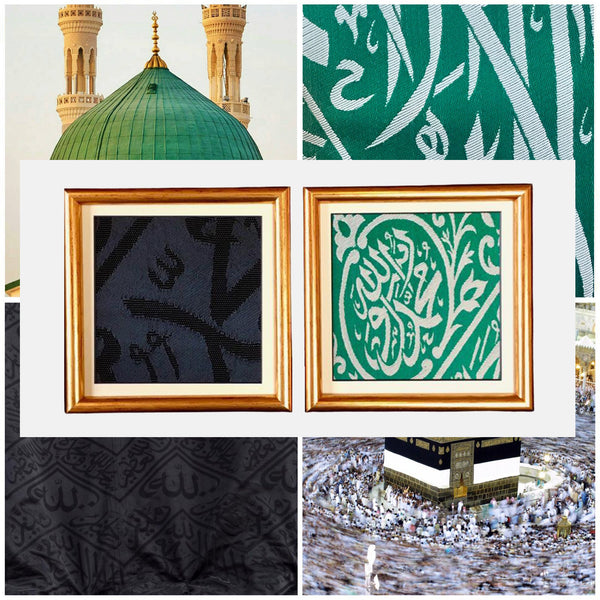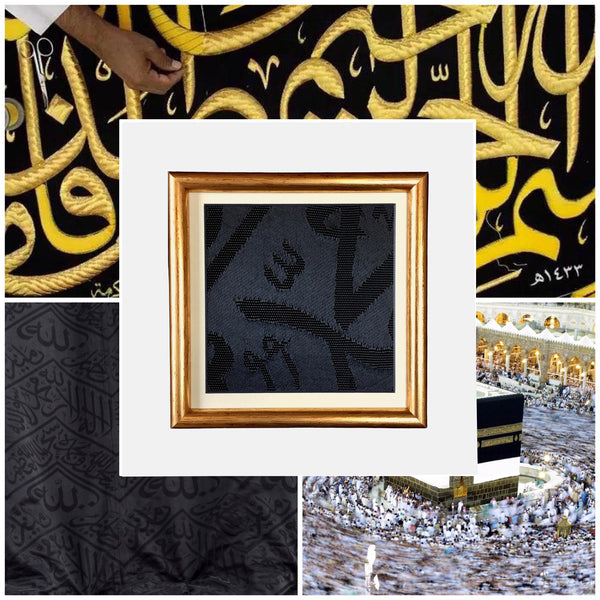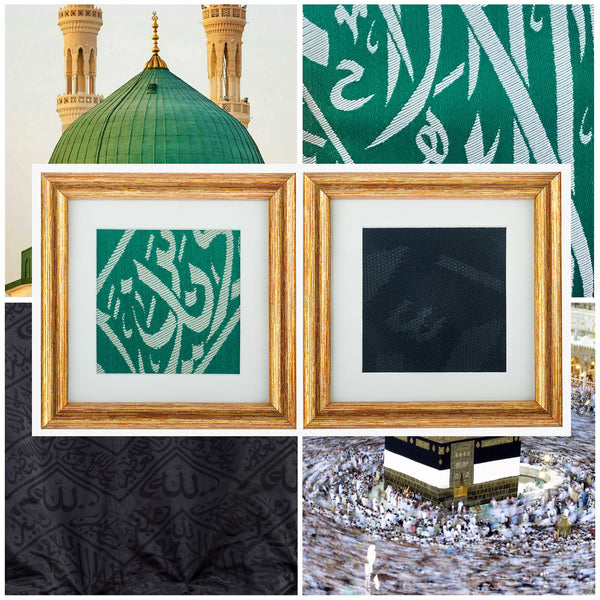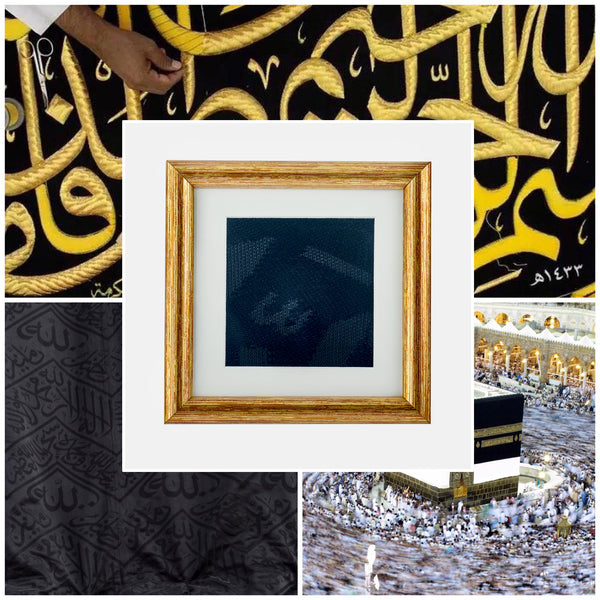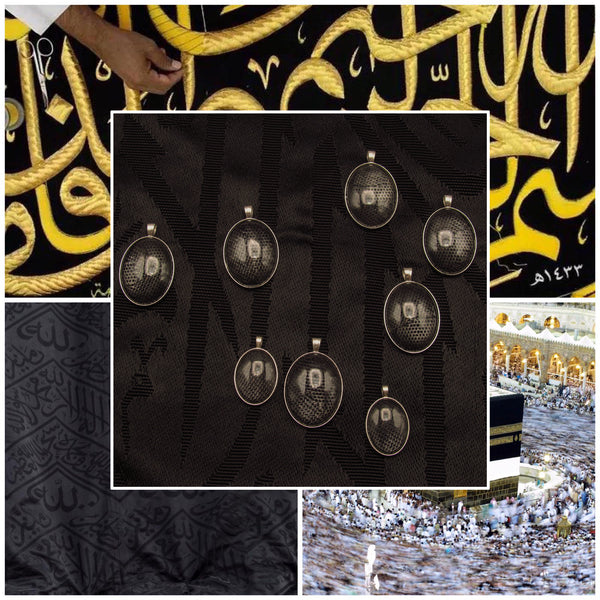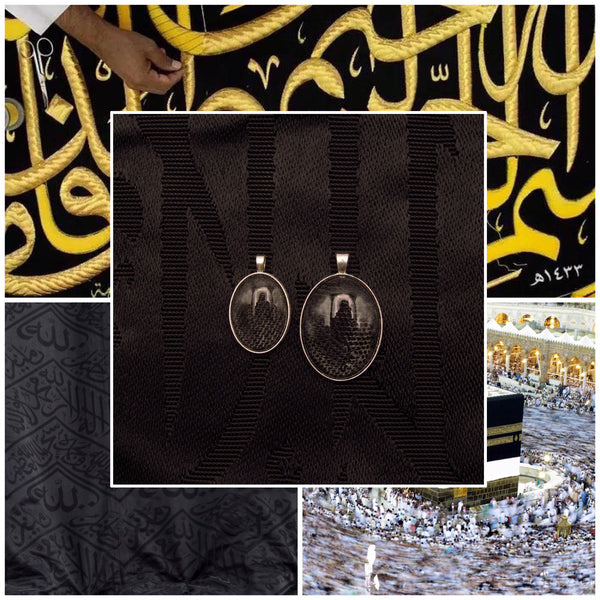Kiswah | Holy Kaaba (Mecca) & Hujra al-Nabawia (Masjid an-Nabawi, Medina)
Authentic, certified kiswah (غلاف ,كسوة, Ghilaf) coverings used on the Holy Kaaba & the Sacred Chamber (Hujra) of Prophet Muhammad ﷺ. Symbollically, the Kiswah serves as a reminder to move towards our inner qibla which is the heart while walking on the path Prophet Muhammad ﷺ.
☾☾☾☾☾
What is the Kiswah (Ghilaf)?
The kiswah which translates to cover is most commonly used to designate the black cloth made in Saudi Arabia that is placed over the Kaaba annually (كسوة الكعبة). It is embroidered in gold and silver thread with verses from the Quran. When the cover is replaced each year, the Saudi government places sections of the old one in its embassies, or gives them to foreign governments, international organizations, and important people most often connected with the clergy or diplomacy.
The kiswah can also refer to the Kiswah al-Sadaat (Curtain of Bliss, كسوة السعدات) which surrounds the tombs of Prophet Muhammad ﷺ, and his two companions, Abu Bakr as-Saddiq (RAA), and Umar ibn al-Khattab (RAA). The area where Prophet Muhammad is burried is the the Sacred Prophetic Chamber (الحجرة النبوية الشريفة) under the green some of Masjid an-Nabawi in Medina.

Is the Holy Ka'aba Kiswah completely handmade?
Unlike the days of old when the Holy Ka’aba Kiswah was made by wooden handlooms, the process of making the black cloth is now highly mechanized. It involves the purchase of extremely high-quality textiles from Italy and Germany which are washed in special detergents in order to remove wax. The cloth is then cooked to a temperature of 90 degrees Celsius (194 Fahrenheit) and washed several times to bring out its natural color. The black dye is then applied.
Has the Holy Ka’aba Kiswah always been made in Saudi Arabia?
The Holy Ka’aba Kiswah started to be made in Saudi Arabia in 1926 for a brief period of time and then the Kingdom resumed making it in 1962.
For the most part, historically, the Holy Ka’aba Kiswah was most often made in Egypt although there had been exceptions to this rule because of political turmoil. The Kiswah was brought from Egypt to Mecca via caravan and there was much celebration surrounding this event.
The Holy Ka’aba kiswah was also rarely made in Baghdad, Cairo, Istanbul, and Yemen among other places.
What are some interesting historical facts about the Holy Ka'aba Kiswah?
1) The covering of the Holy Ka’aba, with a Kiswah, predates Islam. It began with a ruler from Yemen, named Karb Ibn Asad, who while passing by Mecca with his army, brought along a huge woven textile which he presented to the caretakers of the Holy Ka’aba. During these early days, different tribes of Mecca would take turns to bring forth the larger covering of the Holy Kaaba. Various tribal leaders would also contribute to the Kiswah by using small cloth pieces to cover the walls of the sanctuary.
2) During the reign of Umar ibn al-Khattab, once the Hajj pilgrimage was over, the blessed Kiswah was cut and distributed to pilgrims. The reason for this was threefold: 1. The pilgrims used the blessed Kiswah as a shelter against the scorching heat of Mecca 2. It was given as a keepsake to remember their pilgrimage 3. It was given for its blessings (barakah); a barakah transferred by God, upon the cloth covering, because of its placement on one of the first sanctuary in the world initially built by Prophet Adam and then Prophet Ibrahim. For Adam, God had ordered him to build a holy site in the shape of a House in Heaven called Baitul Ma’amur; This is the heavenly house that contains the divine throne in which the angels circumambulate. This ritual, of the angels, is reenacted by pilgrims during the Hajj and symbolizes the pilgrims entry into the divine presence. As Muslims, we believe that Adam's Kaaba was destroyed by the neglect of believers and the flood, and according to the Quran (2:127) Abraham and his son, Ismail, rebuilt the holy house.
3) The grandmother of Prophet Mohammed ﷺ had once offered a white Kiswah to cover the Holy Ka’aba. Prophet Mohammed ﷺ used Kiswah made of Yemeni cloth and the Companions of the Prophet ﷺ and Caliphs, Umar ibn al-Khattab and Uthman ibn Affan would cover the Holy Ka’aba with an Egyptian white cloth called Qubati. Haroon Al-Rasheed used a white blessed Kiswah as well.
4) Throughout history, the blessed Kiswah of the Holy Ka’aba was changed during different dates depending on the reigns of different Caliphs and Sultans. Originally, it was replaced on the the10th of Muharram, but this was shifted to the 10th of Dhul Hijjah. Muawiyah I, the companion of the Prophet ﷺ and fifth caliph, replaced the covering of the Holy Ka’aba both on the 10th Muharram and Eid ul-Fitr.
5) There were seven historical occasions in which the structure of the Holy Ka’aba was about to collapse because of the exaggerated weight of the blessed Kiswah piled upon it.
6) The Holy Ka’aba covers came in different colors during different periods of Islam. The 34th Abbasid Caliph in Baghdad, Caliph Al-Nasir li-Din Allah (reign from 1180-1225), first had the Holy Ka’aba covered with a green Kiswah, but later changed it to a black covering starting in 1224. This is the starting date of the long tradition of the black blessed Kiswah.
7) In the Ottoman period, black covers were created with inscriptions, whereas the inner walls of the Holy Ka’aba had red curtains.
8) When Ottoman Sultan Selim I, who reigned from 1512 to 1520, became responsible for the Haramayn, the covers of the Holy Ka’aba were woven in Egypt and many well-funded foundations were established. This tradition continued until the reign of Sultan Ahmet I.
9) To show respect toward the Holy Ka’aba, Sultan Ahmet I, who reigned from 1603-1617, ordered that the covers be woven in Istanbul. He was so enamored by the Holy Ka’aba that we wanted to rebuild it out of gold and silver bricks! However, the Grand Mufti of the time spoke up and said that God would have made the Ka’aba out of Beryl (an extremely rare stone) if He so willed. This stopped the Sultan from implementing his idea.
10) Historically, the Kiswah of the Holy Ka’aba would come from Cairo, Baghdad, Istanbul, and Yemen depending on whose political influence was greater in Mecca. The making of the Kiswah was one of the greatest honors bestowed on any leader and region. Creating and beautifying the Kiswah was not only done out of religious piety but also had beneficial political repercussions for the region making it. For the most part, even in the early days, Egypt most often had the honor of making the blessed Kiswah.
11) After Egypt left the Ottoman Empire, in the time of Mohammed Ali Pasha (reined from 1805 – 1848), he made the making of the blessed Ka’aba Kiswah a state responsibility. The Kiswah was brought by an annual caravan from Cairo to Mecca and was received with an elaborate festival.
12) With Turkey’s involvement in World War I, there was uncertainty that it would be possible to bring the Kiswah from Egypt to Mecca. Turkey, therefore organized the making of grand Kiswa from Istanbul and via the Hijaz Railway it was sent to Medina. However, the Kiswah from Egypt reached Mecca on time, and the Istanbul Kiswa was left in Medina.
13) In 1923, the relationship between the Sheriff of Mecca and Egypt was fractured and Egypt called back the Kiswah that was made for the Holy Ka’aba although it had reached Jeddah at the time. In haste, the Istanbul Kiswah that was left in Medina previously was used. This incident and others from the following year, had Ibn Saud use Kiswahs made in Iraq for the Holy Ka’aba.
14) In 1926, a factory was set up in Mecca by King Abdul Aziz to make Kiswah in Mecca. One hundred craftsmen were contracted from India and it took a whole year to weave the cloth on wooden handlooms and to make the beautiful golden calligraphy. In 1937 the factory was closed.
15) In 1962, the factory was reopened and continued to develop into ‘The Kiswah Factory’ that we know today. The Kiswah Factory uses the best textiles and the most advanced machinery to create the blessed Kiswah and its craftsmen and embroiderers are second to none.
What does the Holy Ka’aba Kiswah (كسوة الكعبة) symbolize?
"Upon the earth are signs for those possessing certainty"
(Quran; 52:20)
To see the true meaning behind the created world is an important concept emphasized in the Holy Quran. In fact, training the mind and the heart to recognize signs is essential for the spiritual seeker.
The Holy Ka’aba itself, and its beautiful veil, are full of symbolism and this can be seen in the many descriptions available in traditional Islamic literature.
To paraphrase one scholar, the Holy Ka’aba can be described to be like a living body, protecting its mysteries with the black cloth - the Kiswah. The darkness of the Kiswah symbolizes the intensity of light; a light so bright that it contains and transcends all colors and forms. The golden letters of the Noble Quran embellish the black Kiswah like the radiance of the sun. Amongst other symbols, the gold represents the Knowing Heart of the believer - free from all impurities.
This is simply one possible interpretation of what the Kiswah can symbolize. In a beautiful article entitled ‘Unveiling the Ka’aba’, Wolfson gives another example:
“The sacred covering of the Ka’aba has the potential to remind the pilgrim that truth exceeds the letters, and yet it is only by way of the letters that one accesses truth. The goal of the path, as Sufīs have continually emphasized for centuries, is to lift the veil to see the face, but it is only through the veil that one can see the face. To see with no veil, therefore, is to see that there is no seeing without a veil, a seeing that liberates the mind of the fanciful urge to posit a face beyond the veil.”
Nifari writes:
"Once you have seen me, unveiling and the veil will be equal. You will not stand in vision until you see my veil as vision and my vision as veil. There is a veil that is not unveiled, and an unveiling that is not veiled. The veil that is not unveiled is knowledge through me, and the unveiling that is not veiled is knowledge through me. No veil remains: Then I saw all the eyes gazing at his face, staring. They see him in everything through which he veils himself. He said to me: They see me, and I veil them through their vision of me from me."
What is the Kiswah al-Saadat?
In 632, while in sickness and lying on the lap of his beloved wife Sayida Aisha (RAA), the Messenger of God ﷺ uttered: "With the supreme communion in Paradise, with those upon whom God hath showered His favor, the prophets and the saints and the martyrs and the righteous, most excellent for communion are they.' He then murmured: "O God, with the supreme communion,"; and these were his last words.
The Prophet Muhammad ﷺ peacefully ended his earthly journey and was buried in Sayida Aisha’s (RAA) room, where he took his last breath. Later, Abu Bakr al-Siddiq (RAA) and Umar ibn al-Khattab (RAA) were also buried in the same vicinity. The mosque was enlarged in later periods, and today these rooms are inside its precincts. The room where God’s Messenger and the first two caliphs lie, known as the Sacred Chamber, is surrounded by a wall and curtains. Visits can only be made in front of the niches outside the curtains. The curtains around the Prophet’s tomb are green with white inscriptions, and they are known as ‘The Curtain of Bliss’ (Kiswah al-Saadat).
Some historical narrations state that the first curtain to cover the Blessed Chamber was donated by the mother of Haroon Rashid, the Abbasid Caliph (786-809 CE), while others say it was his wife. Soon after this donation, throughout the Abbasid times, the coverings of the Blessed Chamber of our Beloved Prophet ﷺ were woven mainly in Egypt. However, after the reign of the Ottoman Empire, the covering was made in Turkey. With the establishment of The Kiswah Factory by the late King Abdul Aziz in 1381, weaving the hujrah kiswah was accomplished by Saudi Arabia and continues to be done by them till today.

